If a tire goes flat, avoid further tire and wheel damage by driving slowly to a level place. Turn on your hazard warning flashers.
Caution: Changing a tire can be dangerous. The vehicle
can slip off the jack and roll over or fall on you or other people. You and they could
be badly injured or even killed. Find a level place to change your tire. To help prevent
the vehicle from moving:
To be even more certain the vehicle will not move, you should put blocks at
the front and rear of the tire farthest away from the one being changed. That would
be the tire, on the other side, at the opposite end of the vehicle.

The following steps will tell you how to use the jack and change a tire.
Removing the Spare Tire and Tools
The equipment you'll need is located in the rear of the vehicle.
- If your vehicle has the cargo management system, remove the storage bin to access the jack.
- Turn the nut holding the jack (and storage tray, if applicable) counterclockwise and remove it. Then remove the jack and wheel wrench.
- The tools you'll be using include the jack (A) and the wheel wrench (B).
If your vehicle has the third row seat, remove the head rest storage tray to access the jack.
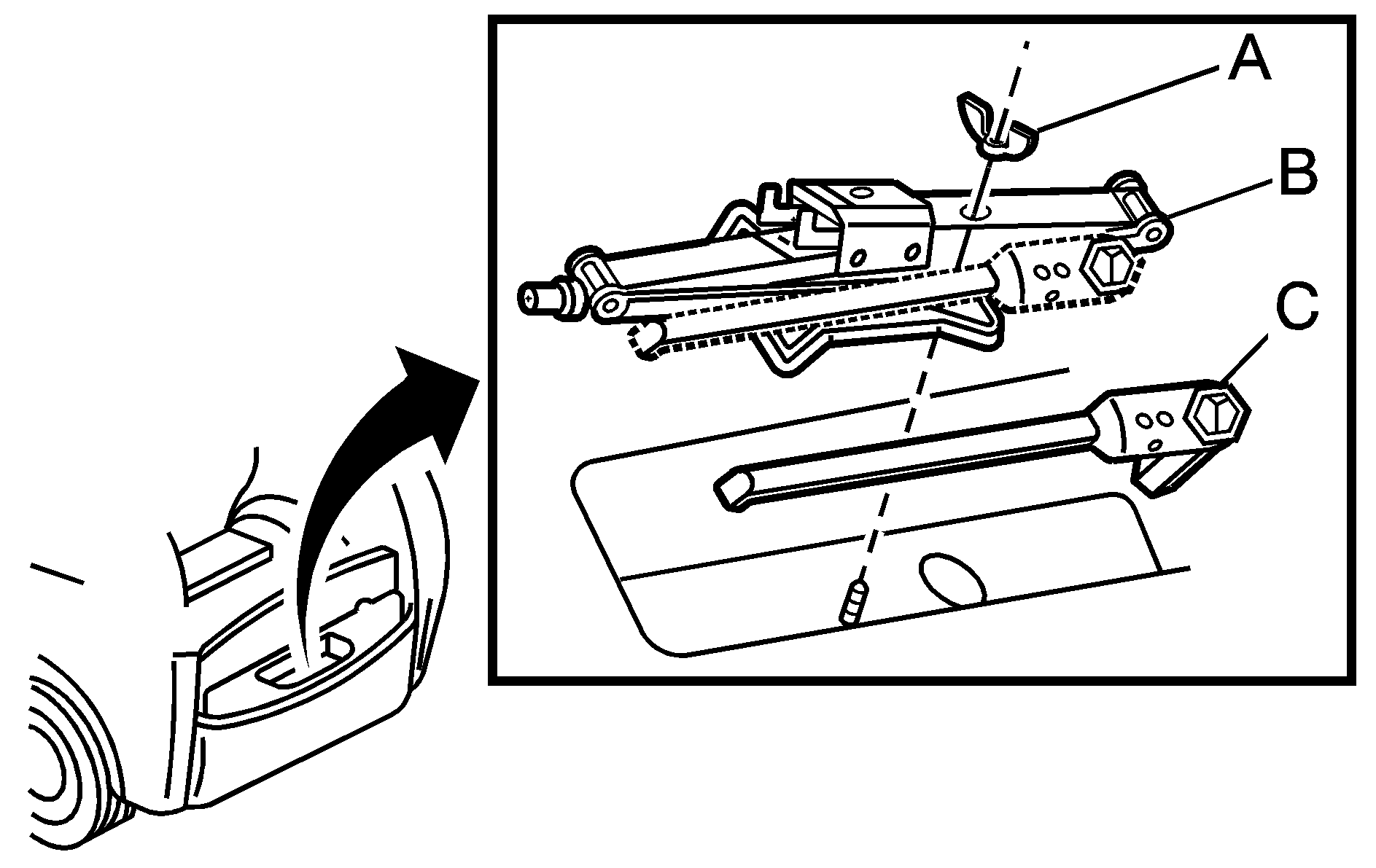
Wing Nut
Jack
Wheel Wrench
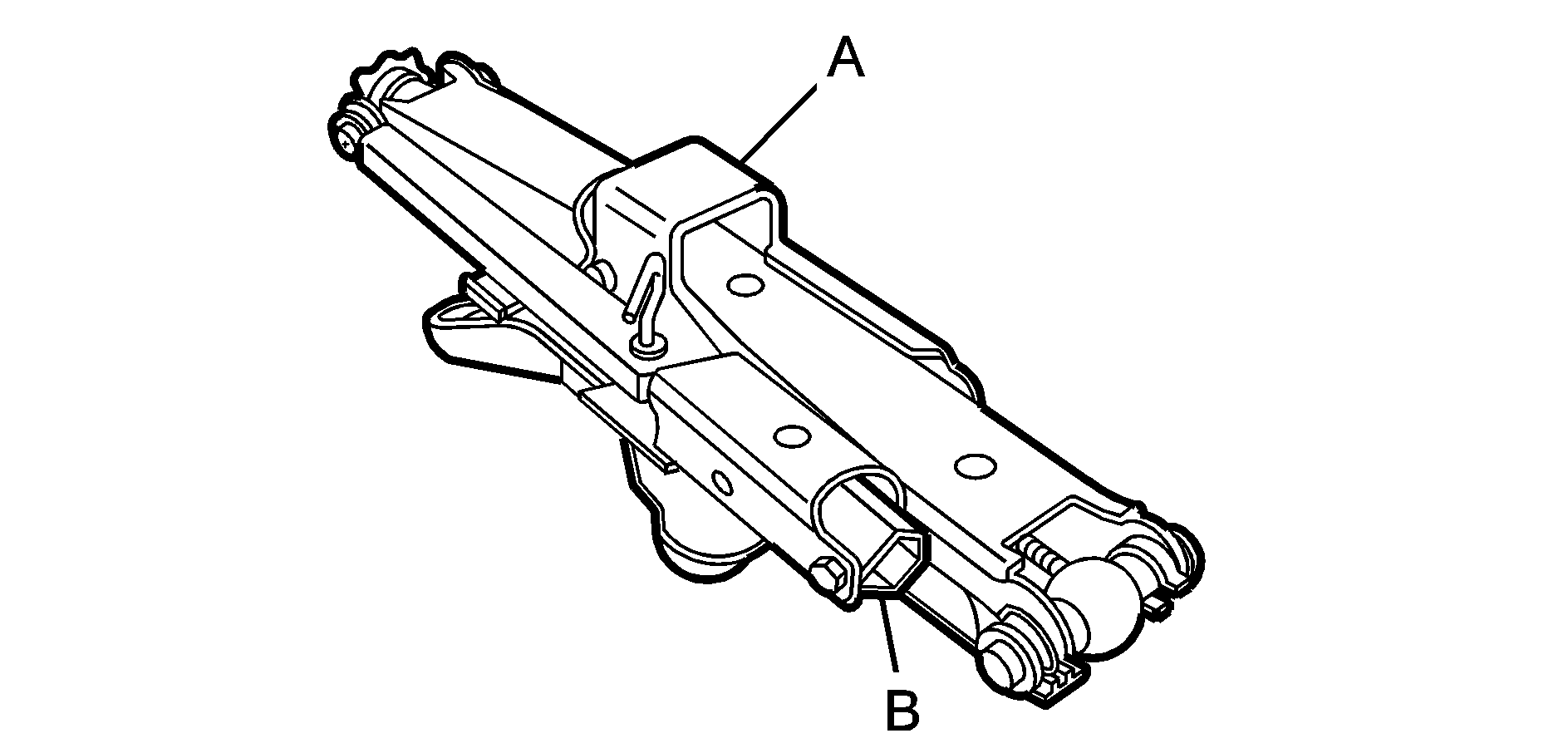
Removing the Spare Tire
The compact spare tire is located under the vehicle, ahead of the rear bumper. See Compact Spare Tire for more information about the compact spare.
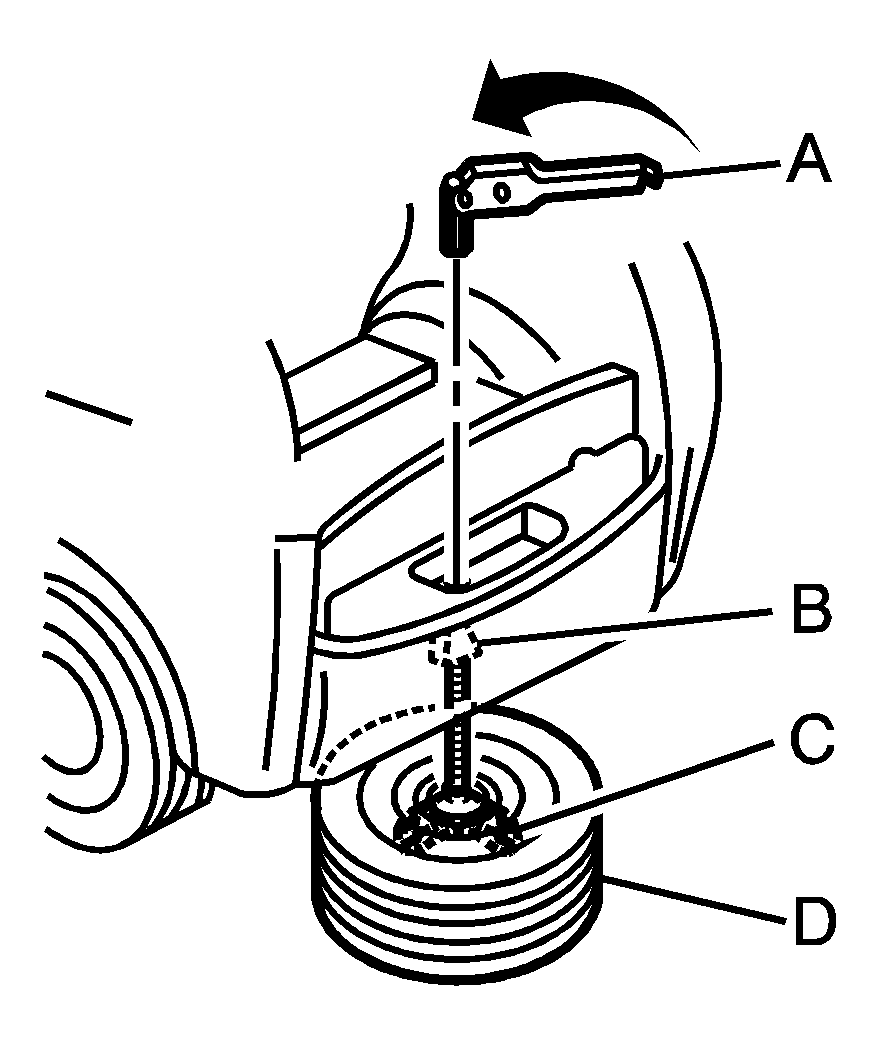
Wheel Wrench
Cable
Retainer
Compact Spare Tire
- Open the storage compartment door of the cargo management system that is nearest the liftgate and remove the removable tub.
- Attach the wheel wrench into the hoist shaft.
- Turn the wheel wrench counterclockwise to lower the spare tire to the ground. Continue turning the wrench until the spare tire can be pulled out from under the vehicle.
- To remove the spare tire from the cable, tilt the retainer and slip it through the wheel opening.
- After removing the spare tire, turn the wrench clockwise to raise the cable back up until you feel two slips or hear two clicks.
Do not store a full-size or a flat road tire under the vehicle. See "Storing a Flat Tire and Tools" later in this section.
To continue changing the flat tire see "Removing the Flat Tire and Installing the Spare Tire" later in this section.
If the spare tire will not lower, the secondary latch may be engaged causing the tire not to lower. Do the following to check the cable:
- Check under the vehicle to see if the cable is visible.
- If it's not visible, see "Secondary Latch System" following.
- Then loosen the cable by turning the wrench counterclockwise three or four turns.
- If the spare tire has not lowered, tighten the cable all the way and then loosen it at least two times.
- If you still cannot lower the spare tire to the ground, see "Secondary Latch System" following.
If it is visible, first try to tighten the cable by turning the wheel wrench clockwise until you hear two clicks or feel it skip twice. You cannot over-tighten the cable.
If the spare tire did lower to the ground, continue with Step 4 under "Removing the Spare Tire" earlier in this section.
Secondary Latch System
Your vehicle has an underbody mounted tire hoist assembly equipped with a secondary latch system. It's designed to stop the compact spare tire from suddenly falling off your vehicle if the cable holding the spare tire is damaged. For the secondary latch to work, the tire must be stowed with the valve stem pointing down. See "Storing the Spare Tire and Tools" later in this section for instructions on storing the spare tire correctly.
Caution: Before beginning this procedure read all the instructions. Failure to read and follow the instructions could damage the hoist assembly and you and others could get hurt. Read and follow the instructions listed next.
To release the spare tire from the secondary latch, do the following:
Caution: Someone standing too close during the procedure could be injured by the jack. If the spare tire does not slide off the jack completely, make sure no one is behind you or on either side of you as you pull the jack out from under the spare.
- If the cable is not visible, start this procedure at Step 3.
- Turn the wrench counterclockwise until approximately 6 inches (15 cm) of cable is exposed.
- Attach the wheel wrench to the jack and raise the jack at least 10 turns.
- Place the jack under the vehicle, ahead of the rear bumper. Position the center lift point of the jack under the center of the spare tire.
- Turn the wheel wrench clockwise to raise the jack until it lifts the secondary latch spring.
- Keep raising the jack until the spare tire stops moving upward and is held firmly in place, this lets you know that the secondary latch has released.
- Lower the jack by turning the wheel wrench counterclockwise. Keep lowering the jack until the spare tire is resting on the wheel wrench.
- Grasp the spare tire with both hands and pull it out from under the vehicle.
- Reach under the vehicle and remove the wheel wrench and jack.
- When the spare tire has been completely lowered, tilt the retainer and slip it through the wheel opening.
- If the cable is hanging, turn the wrench clockwise to raise the cable back up.
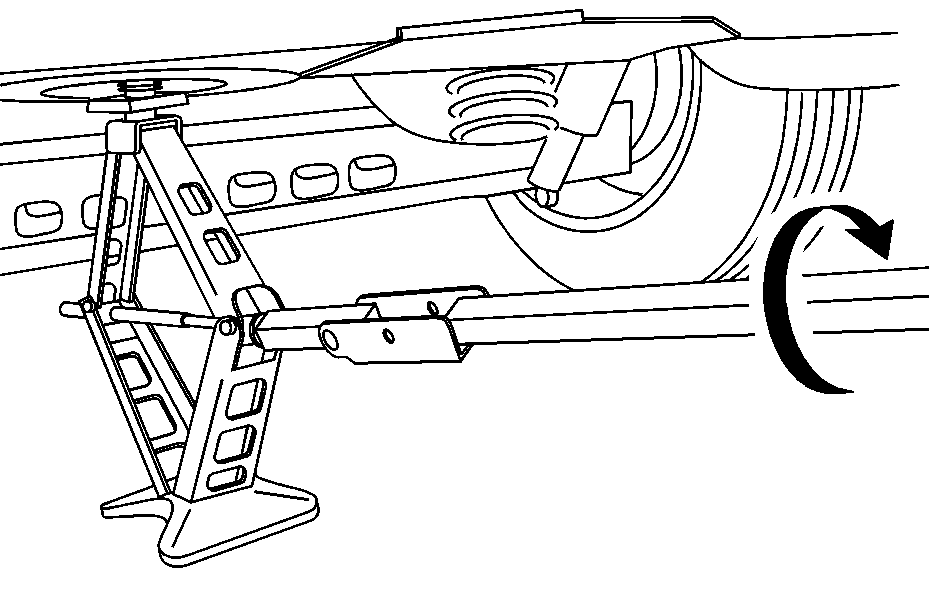

Have the hoist assembly inspected as soon as you can. You will not be able to store a spare tire using the hoist assembly until it has been repaired or replaced.
Removing the Flat Tire and Installing the Spare Tire
- Using the flat end of the wheel wrench, pry off the center cap at the notch. Be careful; the edges may be sharp. Don't try to remove the cover with your bare hands.
- Loosen the wheel nuts - but do not remove them - using the wheel wrench. (Turn the handle about 180 degrees, then flip the handle back to the starting position. This avoids taking the wrench off the lug nut for each turn.)
- Attach the wheel wrench to the jack.
- Turn the wheel wrench clockwise to raise the jack lift head until the jack just fits under the vehicle.
- Raise the jack by turning the wheel wrench clockwise until the slots in the jack head fit into the metal flange located behind the triangle on the plastic molding as shown.
- Put the compact spare tire near you.
- Raise the vehicle by turning the wheel wrench clockwise. Raise the vehicle far enough off the ground for the compact spare tire to fit under the vehicle.
- Remove all the wheel nuts and take off the flat tire.
- Remove any rust or dirt from the wheel bolts, mounting surfaces and spare wheel.
- Install the spare tire and put the wheel nuts back on with the rounded end of the nuts toward the wheel. Tighten each nut by hand until the wheel is held against the hub.
- Lower the vehicle by attaching the wheel wrench to the jack and turning the wrench counterclockwise. Lower the jack completely.
- Tighten the wheel nuts firmly in a crisscross sequence, as shown.
- Don't try to put a wheel cover on the compact spare tire. It won't fit. Store the wheel cover securely in the rear of the vehicle until you have the flat tire repaired or replaced.
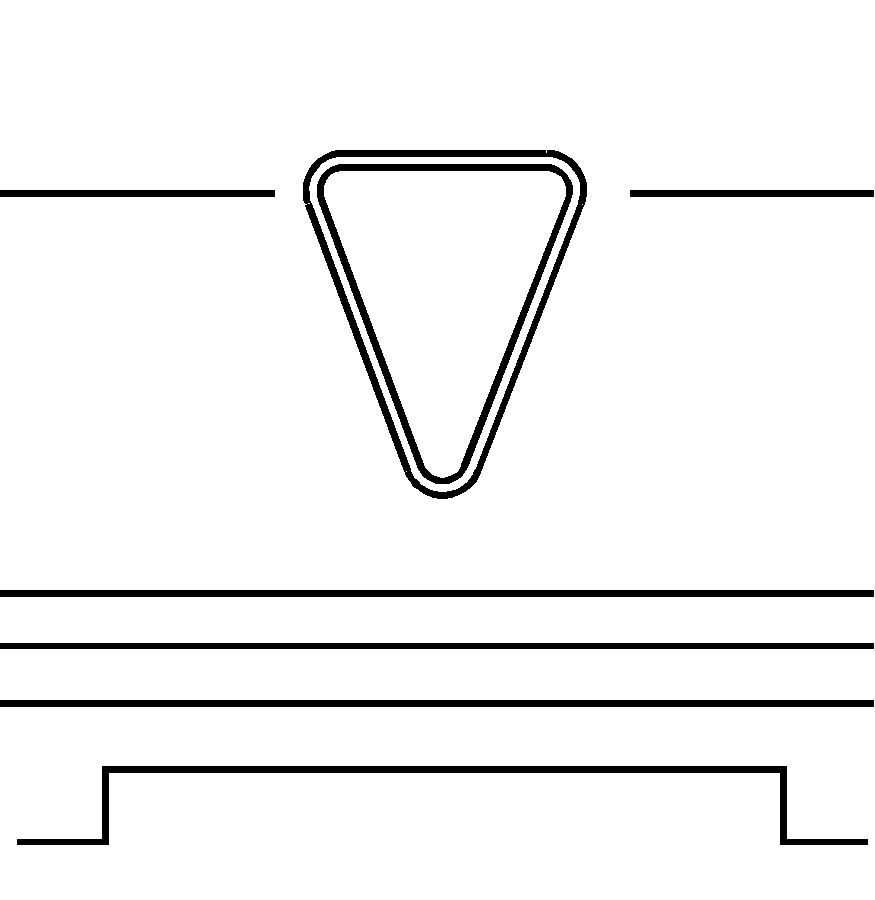
Find the jacking location using the hoisting notches located in the plastic molding. The notches in the plastic molding are marked with a triangle shape to help you find them.
Caution: Getting under a vehicle when it is jacked up is dangerous. If the vehicle slips off the jack you could be badly injured or killed. Never get under a vehicle when it is supported only by a jack.
Caution: Raising your vehicle with the jack improperly positioned can damage the vehicle and even make the vehicle fall. To help avoid personal injury and vehicle damage, be sure to fit the jack lift head into the proper location before raising the vehicle.
Caution: Lifting a vehicle and getting under it to do maintenance or repairs is dangerous without the appropriate safety equipment and training. If a jack is provided with the vehicle, it is designed only for changing a flat tire. If it is used for anything else, you or others could be badly injured or killed if the vehicle slips off the jack. If a jack is provided with the vehicle, only use it for changing a flat tire.
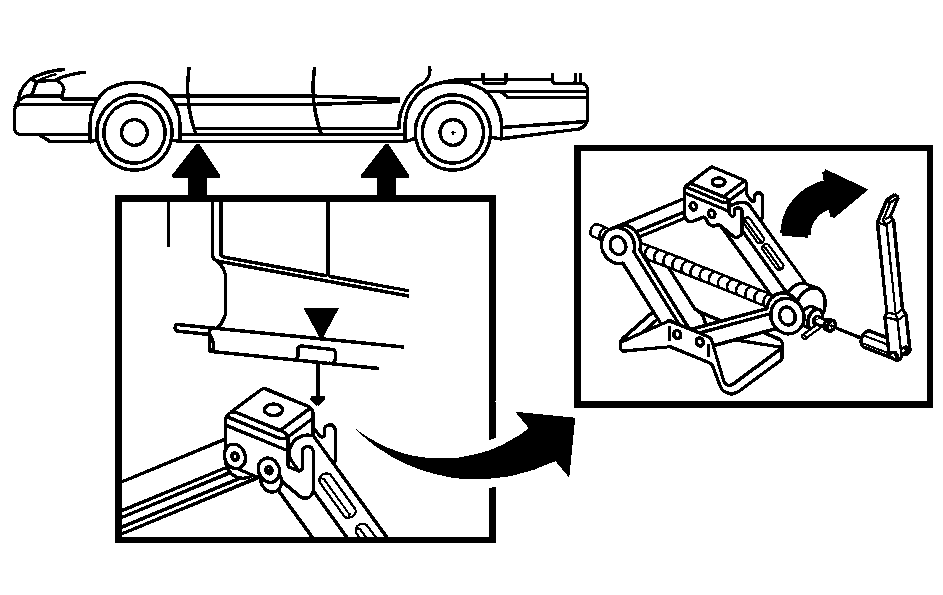
Notice: Using a jack to raise the vehicle without positioning it correctly could damage your vehicle. When raising your vehicle on a jack, be sure to position it correctly under the frame and avoid contact with the plastic molding.
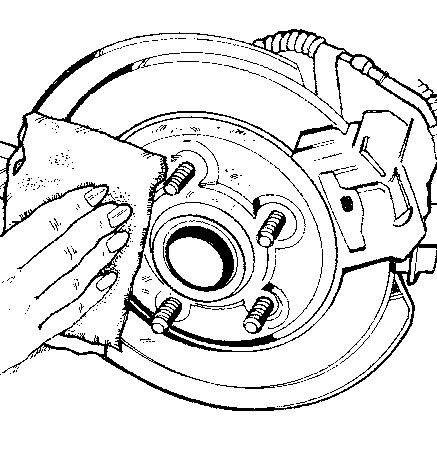
Caution: Rust or dirt on a wheel or other parts to which it is fastened, can make the wheel nuts become loose and eventually the wheel could come off and cause a crash. Always remove all rust and dirt from wheels and other parts.
Caution: Never use oil or grease on bolts or nuts because the nuts might come loose. The vehicle's wheel could fall off, causing a crash.

Caution: Incorrect wheel nuts or improperly tightened wheel nuts can cause the wheel to become loose and even come off. This could lead to an accident. Be sure to use the correct wheel nuts. If you have to replace them, be sure to get new GM original equipment wheel nuts. Stop somewhere as soon as you can and have the nuts tightened with a torque wrench to 100 lb-ft (140 N·m).
Notice: Improperly tightened wheel nuts can lead to brake pulsation and rotor damage. To avoid expensive brake repairs, evenly tighten the wheel nuts in the proper sequence and to the proper torque specification.
Notice: Wheel covers will not fit on your vehicle's compact spare. If you try to put a wheel cover on the compact spare, the cover or the spare could be damaged.
Storing the Flat Tire and Tools
Caution: Storing a jack, a tire, or other equipment in the passenger compartment of the vehicle could cause injury. In a sudden stop or collision, loose equipment could strike someone. Store all these in the proper place.
Storing the Flat Tire with Third Row Passengers

Put back all tools as they were stored in the rear storage compartment and put the compartment cover back on.
- Use the power third row seat button near the liftgate to tilt the third row seatback forward slightly.
- Place the flat tire in the tire storage bag and put the tire in an upright position against the third row seat.
- Route the tie-down strap through the tire as shown in the graphic and attach the strap to the cargo tie-downs in the rear of the vehicle.
- Tighten the tie-down strap.
Storing the Flat Tire with a Flat Load Floor
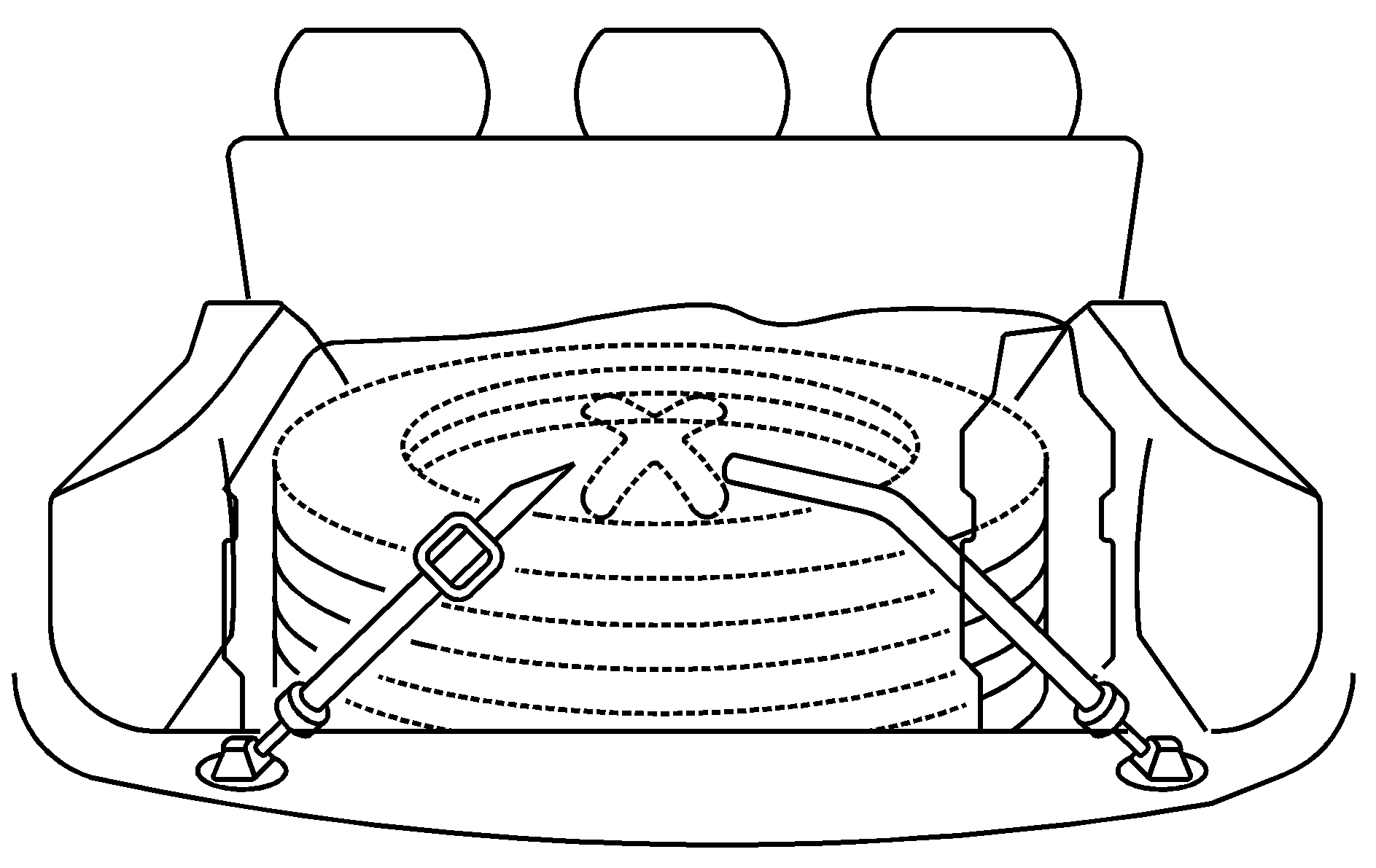
Put back all tools as they were stored in the rear storage compartment and put the compartment cover back on.
- Place the flat tire in the tire storage bag and put the tire in a horizontal position on the floor in the rear of the vehicle.
- Route the tie-down strap through the tire as shown in the graphic and attach the strap to the cargo tie-downs in the rear of the vehicle.
- Tighten the tie-down strap.
Storing the Spare Tire and Tools
Caution: Storing a jack, a tire, or other equipment in the passenger compartment of the vehicle could cause injury. In a sudden stop or collision, loose equipment could strike someone. Store all these in the proper place.
Caution: The underbody-mounted spare tire needs to be stored with the valve stem pointing down. If the spare tire is stored with the valve stem pointing upwards, the secondary latch will not work properly and the spare tire could loosen and suddenly fall from the vehicle. If this happened when the vehicle was being driven, the tire might contact a person or another vehicle, causing injury and damage to itself. Be sure the underbody-mounted spare tire is stored with the valve stem pointing down.
- Lay the compact spare tire on the ground at the rear of the vehicle. Position the compact spare tire so that the valve stem is pointed down facing the rear of the vehicle.
- Lower the cable to the ground. See "Removing the Spare Tire" earlier in this section.
- Tilt the retainer downward and slip it through the center hole of the spare tire.
- Attach the wheel wrench to the hoist shaft.
- Turn the wheel wrench clockwise to lift the spare tire.
- When the tire is almost in the stored position, turn the tire so that the valve stem is towards the rear of the vehicle.
- Raise the tire fully against the underside of the vehicle. Continue turning the wheel wrench until you feel more than two clicks. This indicates that the compact spare tire is secure and the cable is tight. The spare tire hoist cannot be overtightened.
- Make sure the tire is stored securely. Push, pull (A), and then try to rotate or turn the tire (B). If the tire moves, use the wheel wrench to tighten the cable.
Make sure the retainer is fully seated across the underside of the wheel.
This will help when you check and maintain tire pressure in the spare.
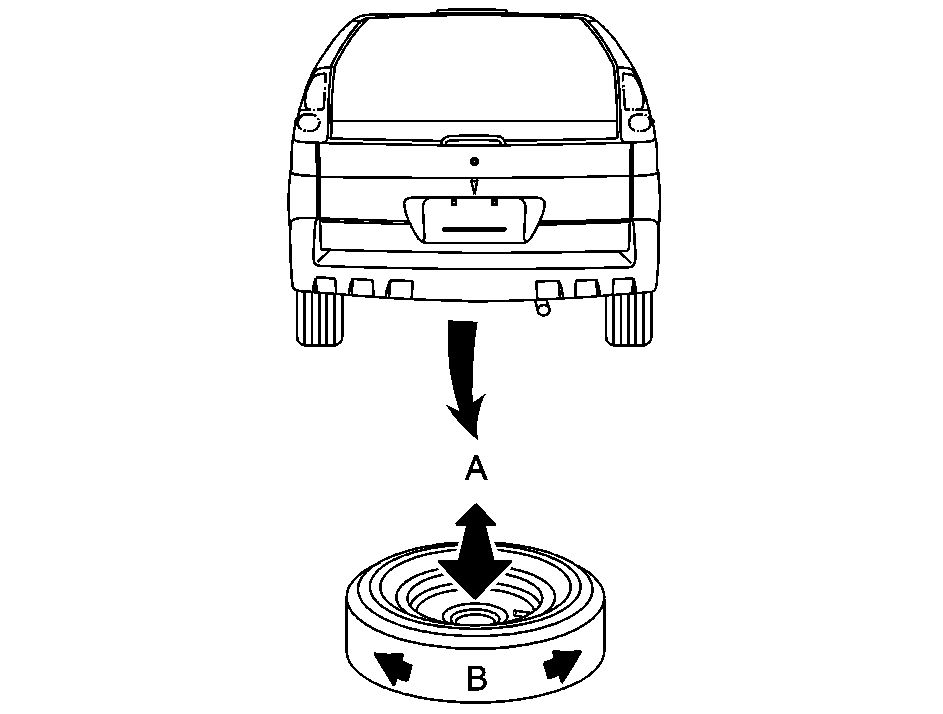
Put back all tools as they were stored in the rear storage compartment and put the compartment cover back on.
